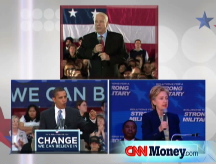U.S. gas: So cheap it hurts
Relatively low taxes have kept pump prices far below most other developed nations, which some say is precisely why the current runup is so painful.
NEW YORK (CNNMoney.com) -- Despite daily headlines bemoaning record gas prices, the United States is actually one of the cheaper places to fill up in the world.
Out of 155 countries surveyed, U.S. gas prices were the 45th cheapest, according to a recent study from AIRINC, a research firm that tracks cost of living data.
The difference is staggering. As of late March, U.S. gas prices averaged $3.45 a gallon. That compares to over $8 a gallon across much of Europe.
The United States has always fought to keep gas prices low, and the current debate among presidential candidates on how to keep them that way has been fierce.
But those cheap gas prices - which Americans have gotten used to - mean they feel price spikes like the ones we're experiencing now more acutely than citizens from other nations which have had historically more expensive fuel.
Cheap gas prices have also lulled Americans into a cycle of buying bigger cars and bigger houses further away from their work - leaving them more exposed to rising prices, some experts say.
Price comparisons are not all created equal. Comparing gas prices across nations is always difficult. For starters, the AIRINC numbers don't take into account different salaries in different countries, or the different exchange rates. The dollar has lost considerable ground to the euro recently. Because oil is priced in dollars, rising oil prices aren't as hard on people paying with currencies which are stronger than the dollar, as they can essentially buy more oil with their money as the dollar falls in value.
And then there's the varying distances people drive, the public transportation options available, and the different services people get in exchange for high gas prices. For example, Europe's stronger social safety net, including cheaper health care and higher education, is paid for partly through gas taxes.
Gas price: It's all about government policy. Gasoline costs roughly the same to make no matter where in the world it's produced, according to John Felmy, chief economist for the American Petroleum Institute. The difference in retail costs, he said, is that some governments subsidize gas while others tax it heavily.
In many oil producing nations gas is absurdly cheap. In Venezuela it's 12 cents a gallon. In Saudi Arabia it's 45.
The governments there forego the money from selling that oil on the open market - instead using the money to make their people happy and encourage their nations' development.
Subsidies, many analysts say, are encouraging rampant demand in these countries, pushing up the price of oil worldwide.
In the United States, the federal tax on gas is about 18 cents a gallon, pretty low by international standards.
But those relatively low gas taxes make it hard now for Americans to deal with gas prices that have risen from around $1 to over $3 a gallon in the last seven years.
"Everybody pays more, but the U.S. pays more in relative terms," said Lee Schipper, a visiting scholar at the University of California Berkeley's Transportation Center. If you're a European and you're already paying $4 in taxes, said Schipper, then an extra $2 a gallon doesn't seem like it's as big of a change as Americans are facing.
Revenues from Europe's high gas taxes are used to fund a variety of things. One thing they have built is better public transportation, said Peter Tertzakian, chief energy economist at ARC Financial, a Calgary-based private equity firm.
They gave people an alternative to driving, something we don't have in North America," said Tertzakian.
Low fuel taxes and prices sprung out of a national love for mobility going back generations, said Robert Lang, director of the urban planning think tank Metropolitan Institute at Virginia Tech.
In fact, the United States could not have had the western expansion it did without the cheap mobility railroads and horse carriages afforded long before it became an auto-obsessed culture, said Lang.
"You couldn't have Manifest Destiny unless you could move," he said.
The automobile, and its promise of personal mobility, only deepened the nation's love affair with travel.
"Nobody sang 'She'll have fun fun fun until her daddy takes the tokens away,'" said Lang. 'It's totally romanticized."
Gas consumption Europe vs. U.S. There is some evidence Europe's high gas taxes have capped its oil consumption.
Oil use in the United Kingdom has basically stayed flat from 1980 to now, while in France it's dropped 17%, according to figures from the Energy Information Administration.
In the United States, meanwhile, oil use is up 21% over the same period, although the country has added more people and seen its economy grow slightly faster.
Americans have taken advantage of cheap gas prices to do other things - like buy bigger cars and bigger houses further away from city centers, said Schipper.
On a per capita basis, Americans use three times more oil than Europeans, he said. That means Americans are more exposed to rising gas prices than their counterparts across the Atlantic.
"Five-thousand square feet in the suburbs, that's much rarer in Europe," said Schipper, referring to big homes. "We dug our hole."
-- Correction: Due to data errors, previous versions of the charts in this story were incorrect. The charts have been updated. And a previous version of this story said Americans pay more for gas in absolute terms, when it should have said relative terms. ![]()



